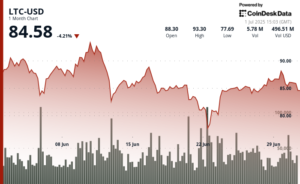Understanding Solana’s Network Extensions: A New Frontier in Blockchain Infrastructure
In the evolving landscape of blockchain technology, Solana’s recent innovation, Network Extensions, promises to reshape how developers approach building applications. While Ethereum is primarily focused on scaling through layer-2 rollups, Solana is presenting an alternative that emphasizes specialization over mere scalability. This article delves into what Network Extensions are, how they function, and their implications for developers and the broader blockchain ecosystem.
The Concept Behind Network Extensions
Network Extensions are not merely a replication of existing solutions like sidechains or appchains; rather, they serve as customizable execution environments within Solana’s core infrastructure. This approach allows developers to create tailored environments without fragmenting liquidity or composability—an essential feature for the growing need for application-specific blockspace. Unlike Ethereum’s rollups, which offload computation yet risk creating siloed environments, Solana is enabling a more seamless integration of diverse applications directly into its ecosystem.
This flexibility means developers can customize logistical aspects such as consensus mechanisms, transaction logic, and storage solutions. By doing so without necessitating the complexity of new chains, Solana ensures that the core network remains robust and cohesive. Essentially, Network Extensions redefine the scale of possibility in blockchain infrastructure by allowing specialization to become a fundamental aspect rather than an optional add-on.
Enhanced Data Availability
A distinctive characteristic of Solana’s Network Extensions lies in its approach to data availability. Unlike Ethereum, which has standardized rollups, Solana is inviting unique experimental approaches as long as these extensions validate state transitions and align with Layer 1. To support this, Solana has introduced specialized data lanes—similar to Ethereum’s blobspace for rollups.
One of the promising innovations is ZK Compression, a collaboration between Helius and Light Protocol that leverages zk-proofs for validating state transitions. This technique compresses account states, allowing Solana to expand its capabilities without compromising validation speed or verifiability. In this way, Solana demonstrates how it is possible to scale efficiently while preserving essential functions necessary for robust blockchain operation.
Comparative Analysis with Ethereum
When comparing Solana and Ethereum, a fundamental difference emerges in their approach to scalability. Ethereum’s rollups focus on increasing throughput with a trade-off in terms of fragmented liquidity and individual state dynamics, while its preconfirmation mechanism attempts to address perceived latency but lacks transformative potential. In contrast, Solana’s Network Extensions empower developers by providing unified execution environments that remain anchored to the primary chain, all while maintaining instant finality.
This inherent design allows Solana to bypass the complexities associated with layer-2 solutions, permitting developers to interact with a more cohesive environment. The result is an architecture that prioritizes flexibility and adaptability over the conventional scaling methods employed by Ethereum, ultimately setting the stage for different kinds of innovative applications.
Implications for Developers
For developers keen on building innovative applications, Network Extensions propose lower barriers to entry, allowing them to create specialized environments without the overhead of managing an entire new chain. As innovation continues to drive demand in various sectors such as finance, supply chain, gaming, and IoT, these specialized execution environments are invaluable.
The capacity to cater to consumer-focused applications significantly enhances user experience, as it allows for tailored solutions. For example, high-frequency trading in Decentralized Finance (DeFi) can benefit from low-latency transactions, while isolated environments in supply chain management ensure data integrity without overwhelming the primary network. The result is that developers are empowered to innovate at an unprecedented level, tailoring their applications to meet specific market needs without compromising performance.
Future Prospects of Network Extensions
Looking ahead, Solana’s Network Extensions exemplify a paradigm shift in how blockchains can scale—not solely by increasing transaction volumes but also by accommodating diverse types of applications. As more developers experiment with these specialized environments, Solana may evolve into a network of purpose-built layers that maintain unity at the foundational level.
This potentially transformative model counters the prevailing trend of fragmentation seen in other blockchain ecosystems. By retaining customization close to the core, Solana ensures ongoing composability, reduces friction, and provides developers ample room for creative expression and functional adaptation.
Conclusion
The success of Solana’s Network Extensions hinges on developer adoption, effective tooling, and real-world application deployment. While the early indicators are encouraging, the true impact of this innovative strategy could fundamentally reshape our understanding of blockchain infrastructure. By shifting focus from traditional scalability to flexibility and adaptability, Solana is paving the way for customized DeFi platforms, next-generation consumer applications, and regulatory-compliant institutional environments. As this program expands, it will be exciting to observe how it redefines not just the Solana ecosystem but potentially the entire blockchain landscape.

















